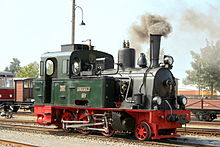PKB No. 21 to 25
| PKB No. 21 to 25 | |
|---|---|
|
Locomotive 23 as SPREEWALD in Bruchhausen-Vilsen, July 22, 2006
|
|
| Numbering: | No. 21-25 DB 99 241, DR 99 5633 |
| Number: | 5 |
| Manufacturer: | Young |
| Year of construction (s): | 1917 |
| Retirement: | 1957/1970 |
| Type : | 1'C n2t |
| Genre : | K 34.7 |
| Gauge : | 1000 mm ( meter gauge ) |
| Length over buffers: | 7030 mm |
| Height: | 3499 mm |
| Width: | 2498 mm |
| Fixed wheelbase: | 2250 mm |
| Total wheelbase: | 3900 mm |
| Service mass: | 26.1 t |
| Friction mass: | 23 t |
| Top speed: | 40 km / h |
| Driving wheel diameter: | 860 mm |
| Impeller diameter: | 620 mm |
| Control type : | Heusinger |
| Number of cylinders: | 2 |
| Cylinder diameter: | 300 mm |
| Piston stroke: | 400 mm |
| Boiler overpressure: | 12 bar |
| Number of heating pipes: | 103 |
| Grate area: | 0.75 m² |
| Evaporation heating surface: | 38.27 m² |
| Water supply: | 2.4 m³ |
| Fuel supply: | 1 t coal |
| Train brake: | Körting suction air brake, 99 5633: from 1954 air brake |
The steam locomotives PKB No. 21 to 25 were developed by the Arnold Jung Lokomotivfabrik in Jungenthal in Kirchen (Sieg) in 1917 for the East German Railway Company in Königsberg and used on the Pillkaller Kleinbahn (PKB), which was re-tracked to 1000 mm in the same year .
history
The Pillkaller Kleinbahn, which opened in 1901 and is located in the far east of East Prussia, was largely destroyed by Russian troops in the winter of 1914/1915. Initially restored provisionally, the lines were converted from 750 mm to 1000 mm gauge from 1916 onwards while operations continued. On July 12, 1917, operations began in meter gauge. The five locomotives were the only ones on the branched network of the railway. In 1938 Pillkallen was renamed Schloßberg, and the Pillkaller Kleinbahn was renamed Schloßberger Kleinbahnen . The locomotives were in use there until the Schloßberg district was cleared and the Red Army advanced in October 1944. Some machines from East Prussia came westward in an unexplained manner.
Locomotive 21 is said to have stood in the western Harz in October 1945. She came to Neustadt an der Weinstrasse . After the ownership structure had been clarified, it was used on the 1000 mm narrow-gauge lines in the Palatinate . It was given the number 99 2700 on June 1, 1948 , derived from the army field railway number it had worn at the end of the war. It was only given the number 99 241 from 1955 . The locomotive was retired on August 16, 1957.
In 1945, locomotive 23 was in a warehouse belonging to the Todt Organization near Finowfurt in Brandenburg . In June 1947 it came to the Spreewaldbahn , where it was given the road number 09-27. After the incorporation into the Deutsche Reichsbahn it got the number 99 5631 after the first general inspection in 1950 , on April 23, 1954 then 99 5633 . It remained in use until the Spreewaldbahn was shut down in 1970. In 1971 it was acquired by the German Railway Association (DEV) and has since been operational on the Bruchhausen-Vilsen-Asendorf museum railway under the name SPREEWALD .
Two more locomotives, numbers 24 and 25, came from RAW Rostock to the Weimar-Rastenberger Eisenbahn on December 21, 1944 , where they were almost not used and were delivered to the Soviet Union in 1946 .
technical features
Due to the war, the fire box and fittings were made of iron on delivery. From 1920, the fire boxes were replaced by those made of copper and the fittings were partly renewed in non-ferrous metal. In the Second World War these were mostly removed again. Two Jung safety valves were located on the steam dome, the flat slide regulator was located in the dome. It was fed with two automatic Strube injectors.
The frame was designed as a water tank, and two water tanks were located on the side of the boiler. The coal crates were on the rear of the cab. The locomotives had steam tones and kerosene lighting.
The leading axle was designed as an Adam's axle . A Scharfenberg coupling was installed as a coupling . Balancing lever couplings were later installed in the DB and DR .
In 1954, a Knorr air brake was installed on 99 5633, as the lever brake was abolished on the Spreewaldbahn at that time . The 99 5633 suffered fire damage in 1963, as a result of which a new driver's cab with a flat roof was built. At DEV, the original arched roof was reconstructed with a ventilation attachment.
literature
- Horst J. Obermayer: Paperback German narrow-gauge steam locomotives . Franckh, Stuttgart 1971, ISBN 3-440-03818-1
- Wolfram Bäumer: The Spreewald. Steam locomotive with a lot of history . In: Die Museums-Eisenbahn 4/1988, pp. 10-19, ISSN 0936-4609
Web links
- Locomotive "Spreewald" / ex DR 99 5633 at the German Railway Association
- The "Spreewaldguste" from Pillkallen (PDF file; 11.92 MB), Ostpreußenblatt of March 11, 1972, p. 11

